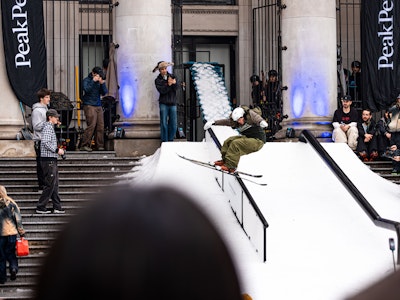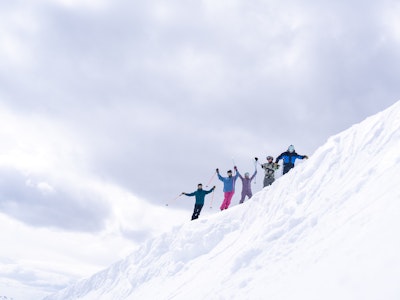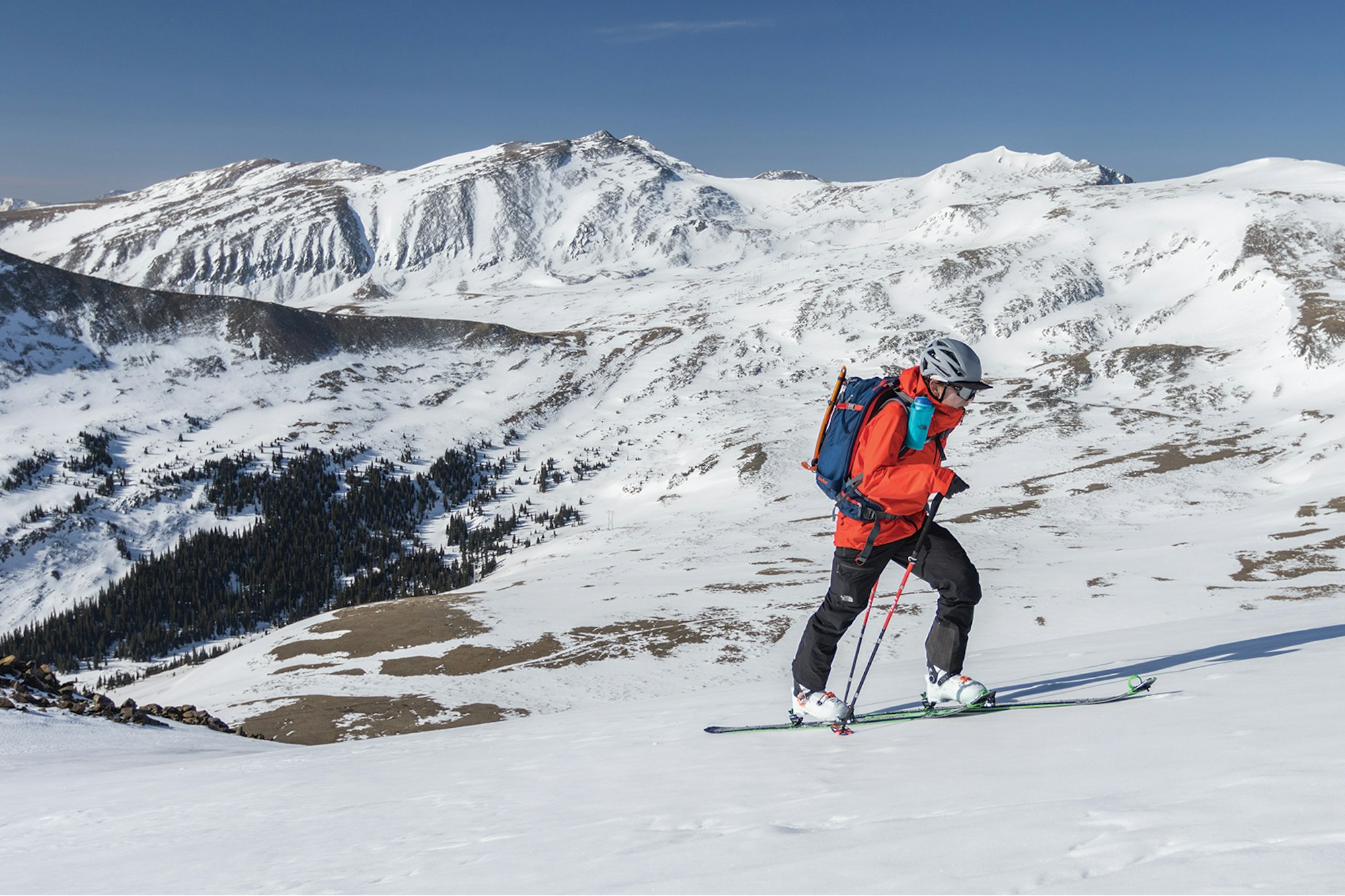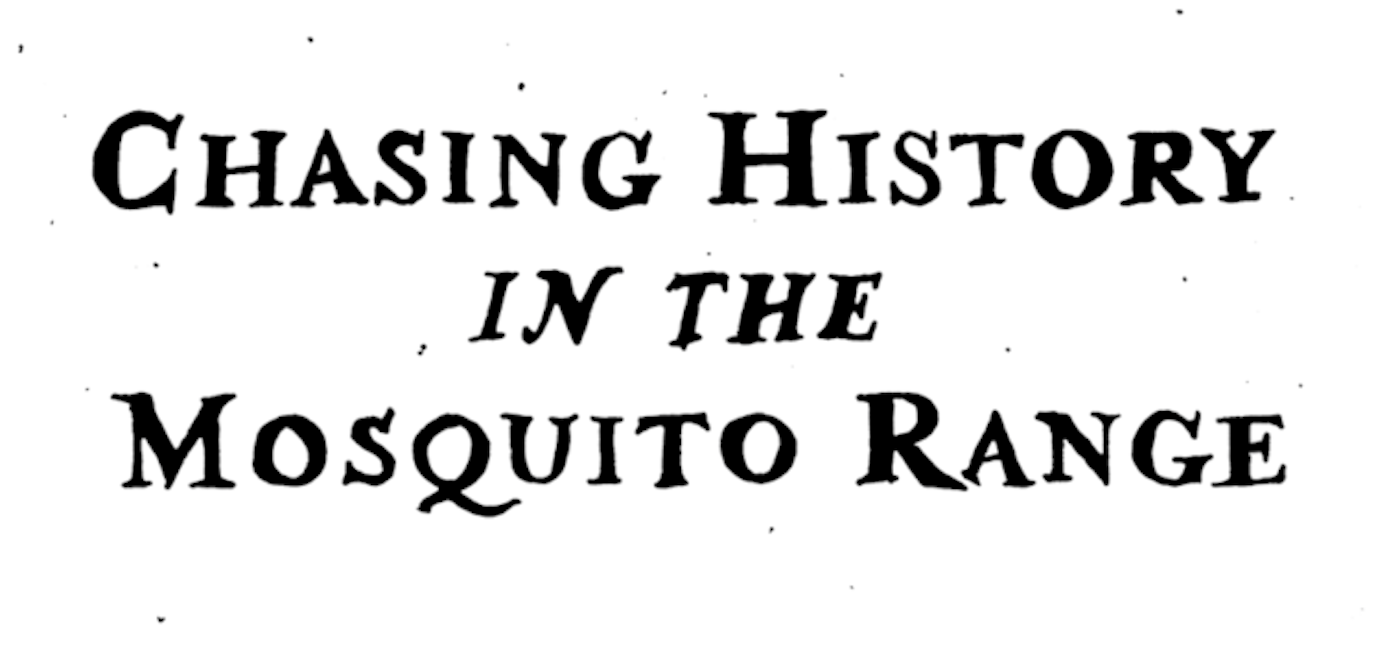
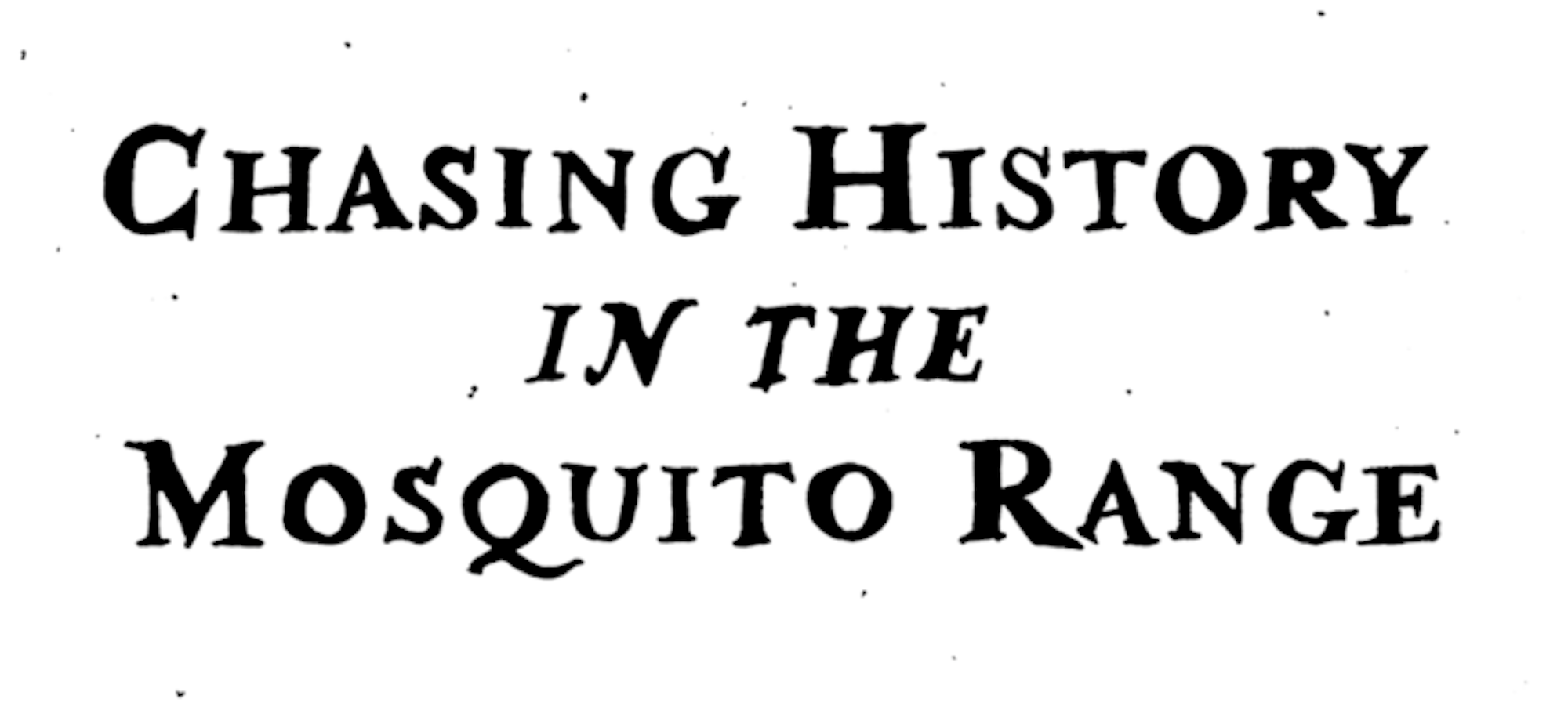
THREE SKIERS RETRACE THE STORIED ROUTE OF THE “SNOW-SHOE ITINERANT”
WORDS • DONNY O’NEILL | PHOTOS • PHIL KRENING | LOCATION • MOSQUITO RANGE, CO
“At sunrise I was near the summit of the range, very weary and sat down under a large rock. I looked through the snow-storm to the east. The sun rose clear, but across South Park the wind was furious and full of snow. The sun penetrated the storm so that the wonders could be clearly seen… Although my situation was very disagreeable, I could stop a few minutes and gaze at this astonishing Rocky Mountain scene, sitting in the storm to watch its wondrous ways.” — John Lewis Dyer, The Snow-Shoe Itinerant.
It’s 1863 and the temperature in Mosquito Gulch sits in the single digits. Night’s dark cloak blacks out the sky and low-hanging storm clouds shroud the mountainous amphitheater in a spooky smog. The wind howls, sending the falling snow sideways and reducing visibility to mere feet. A middle-aged man, sporting a tattered miner’s jacket and affixed to two 10-foot long wooden skis, trudges slowly through two feet of snow, a hulking leather pack strapped to his back.
He pulls a cotton kerchief up over his face and continues on, one slow step after another. Along with the constant roar of ferocious wind, the only audible sound comes from the crunching beneath his feet as he breaks through layers of snow. A cracking sound ahead, like a collapsing tree, floods the airwaves, followed by a low rumble. He stops. The gulch quiets down and the whistling gale presents itself again. The man looks ahead into the blackness and takes an icy breath. Father John L. Dyer has a long way to go.
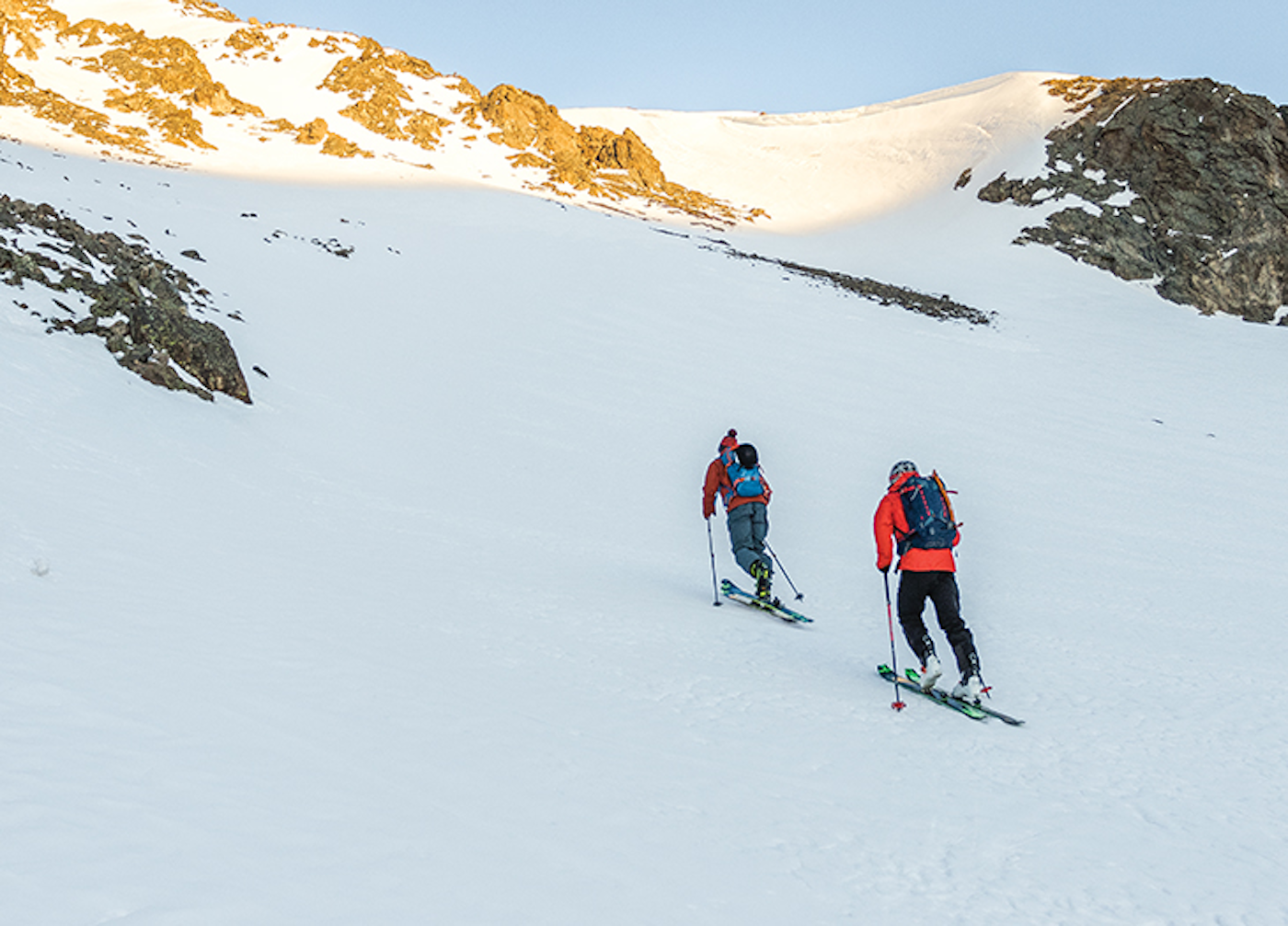
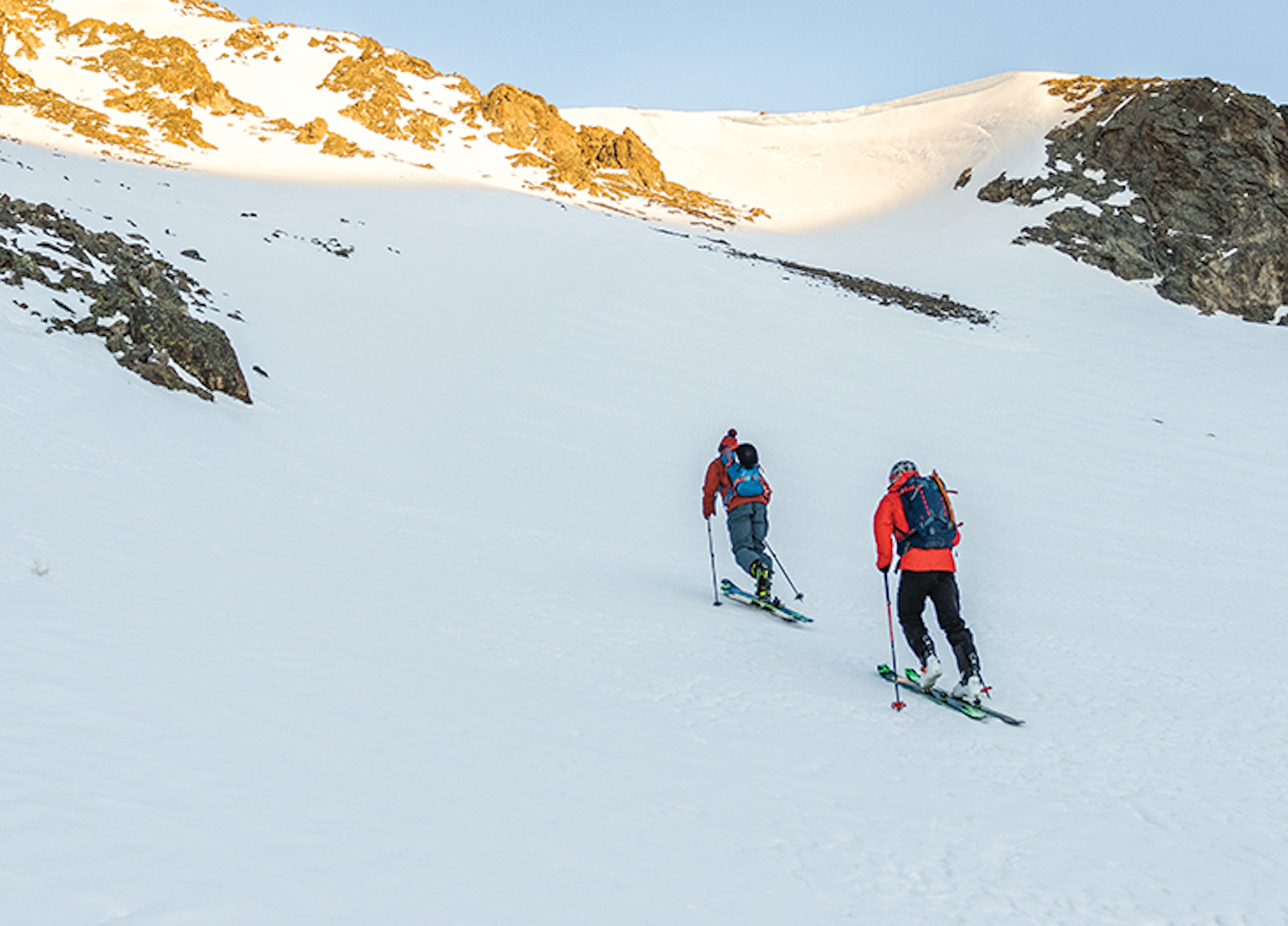
Ascending London Mountain at sunrise.
John Lewis Dyer is considered one of the 16 principal founders of the state of Colorado, and is enshrined via a stained glass portrait in the Colorado State Capitol building. He moved to Colorado, walking 600 miles from Omaha, Nebraska, in order to see the beauty of Pike’s Peak before his vision failed him. A Methodist minister, he walked another 100 miles to the Buckskin Joe mining camps to preach in the mountainous communities of central Colorado beginning in the 1860s. He condemned the common activities of gambling, drinking and prostitution. He is a legend of the Centennial State, and not for any reason relating to the subject matter of his sermons. Dyer was a skier, but, more importantly, an adventurer, and represents a collision of western history with modern day skiing that goes unnoticed by many of today’s backcountry recreationists.
In 1864, with a stagnant cash flow, Dyer took on a job as a courier for the postal service. Once a week, the 52-year-old would travel from the mining camp of Buckskin Joe (two miles west of Alma) over 13,182-foot Mosquito Pass and down to Oro City (a mile northeast of Leadville) and back to deliver the mail—usually about 25 pounds worth. In the winter, he did so on Norwegian “snow shoes,” which were primitive wooden skis fashioned from pine logs standing 10 to 12 feet tall.
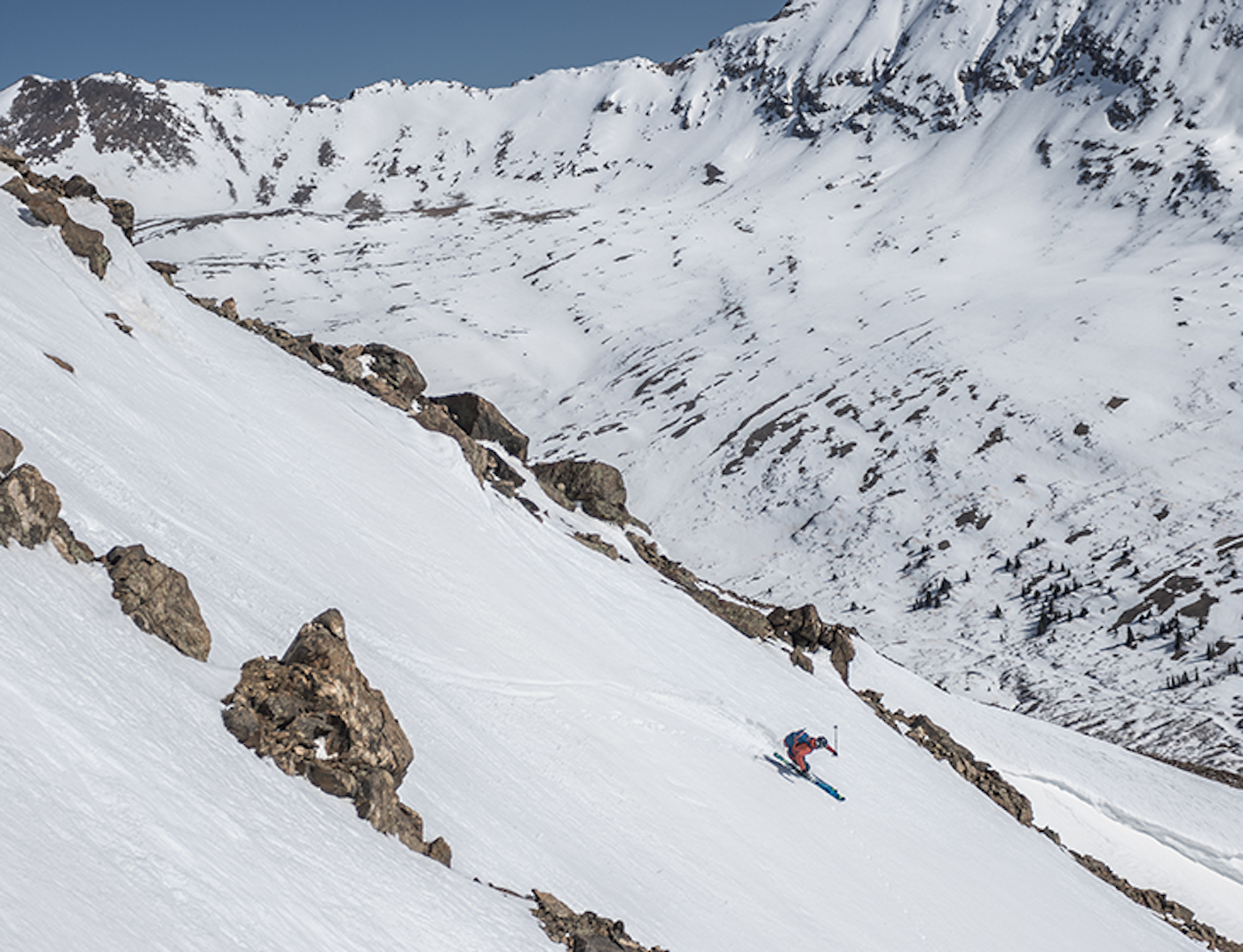
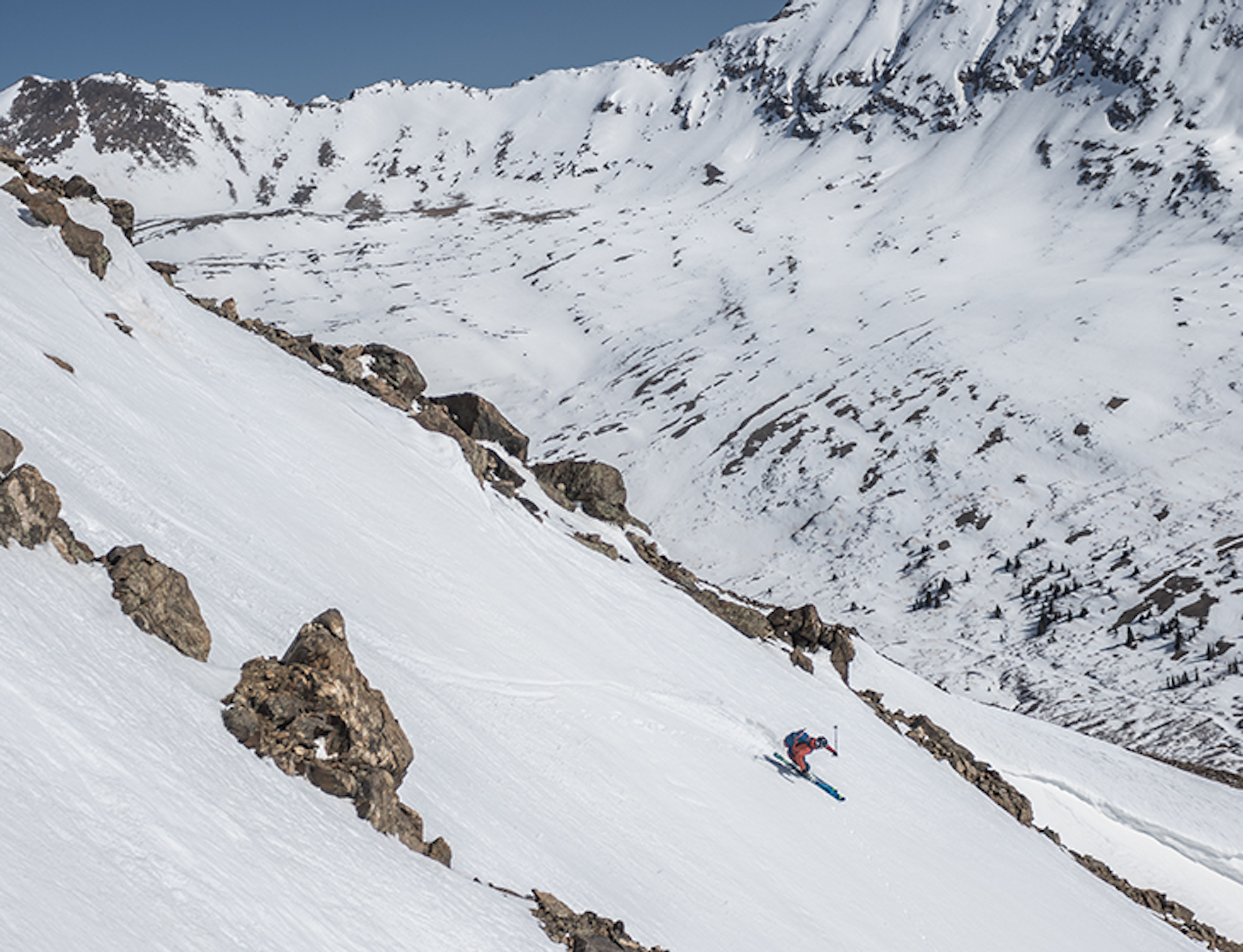
Editor Donny O’Neill coming down “Jack the Ripper.”
Mosquito Pass is cut through the northern reaches of the Mosquito Range. Known for fierce wind, extreme precipitation and bone-chilling temperatures, the range isn’t Colorado’s most welcoming group of mountains. Yet, nearly 160 years ago, a man traveled the pass weekly in the dead of winter without modern equipment, adequate understanding of snow science or a regular companion. He did it to preach in the sinful mining camps and make an extra buck carrying mail, but also to fulfill the primal need of America’s frontiersmen to explore and test themselves in the wild of the western territories.
As a backcountry skier and Colorado resident, the stories of Dyer’s travels caught my attention. I first learned of his mountain exploits in Fritz Sperry’s guidebook, Making Turns in the Tenmile Mosquito Range. Last spring, spurred by the curiosity to make Dyer’s journey in 2018, I joined friends Nat Houston and Phil Krening on a ski touring voyage from Alma over Mosquito Pass and into Leadville. In the nature of good fun, we threw in a peak descent along the way. We walked away with a deep fascination of the explorers who lived and settled in the mountains we now play in. We appreciated the impact that the 19th century fortune-seekers of the Pike’s Peak Gold Rush had on our ability to access and ski the mountains—seeking a fortune of fun, if you will—in 2018.
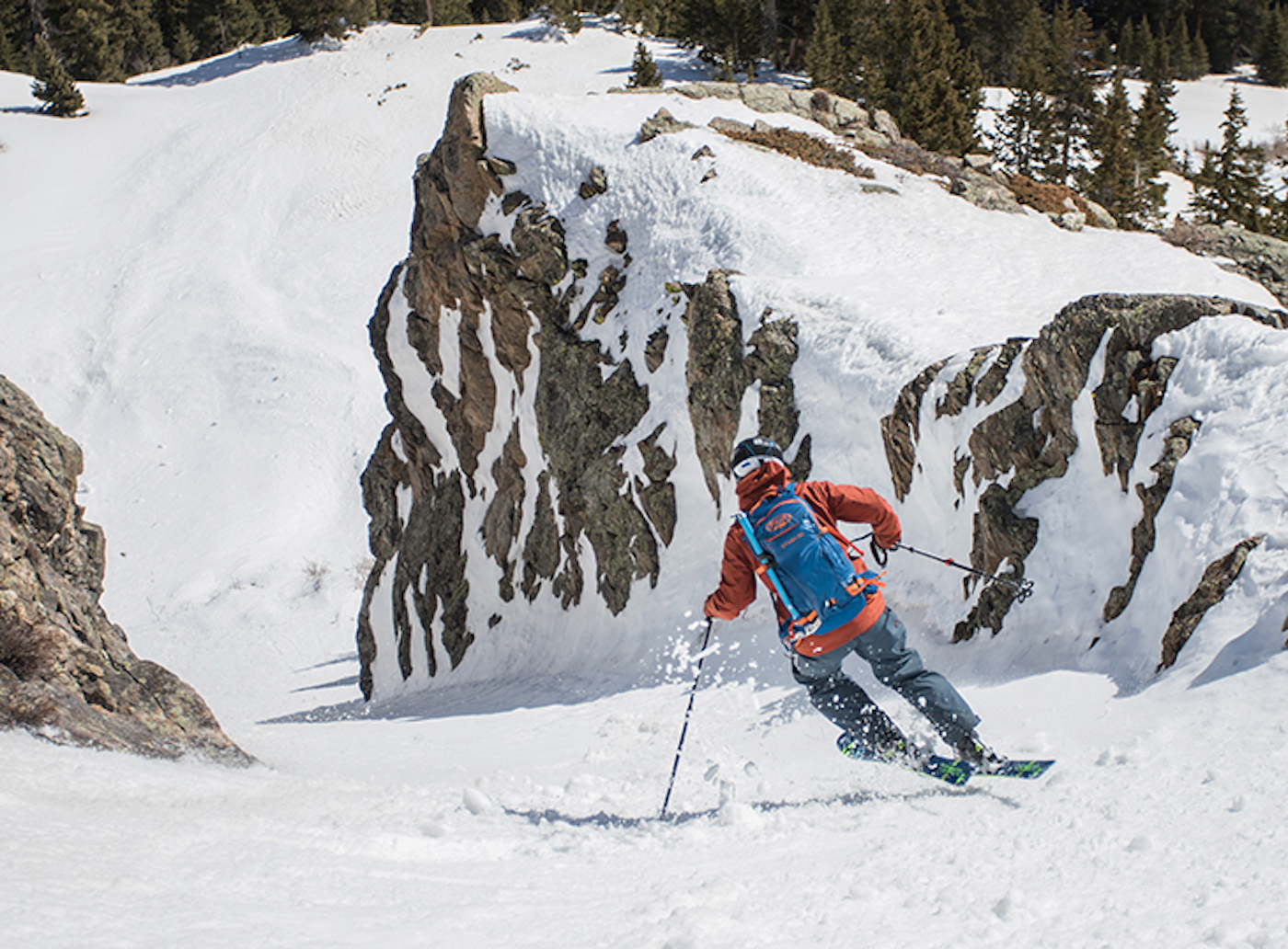
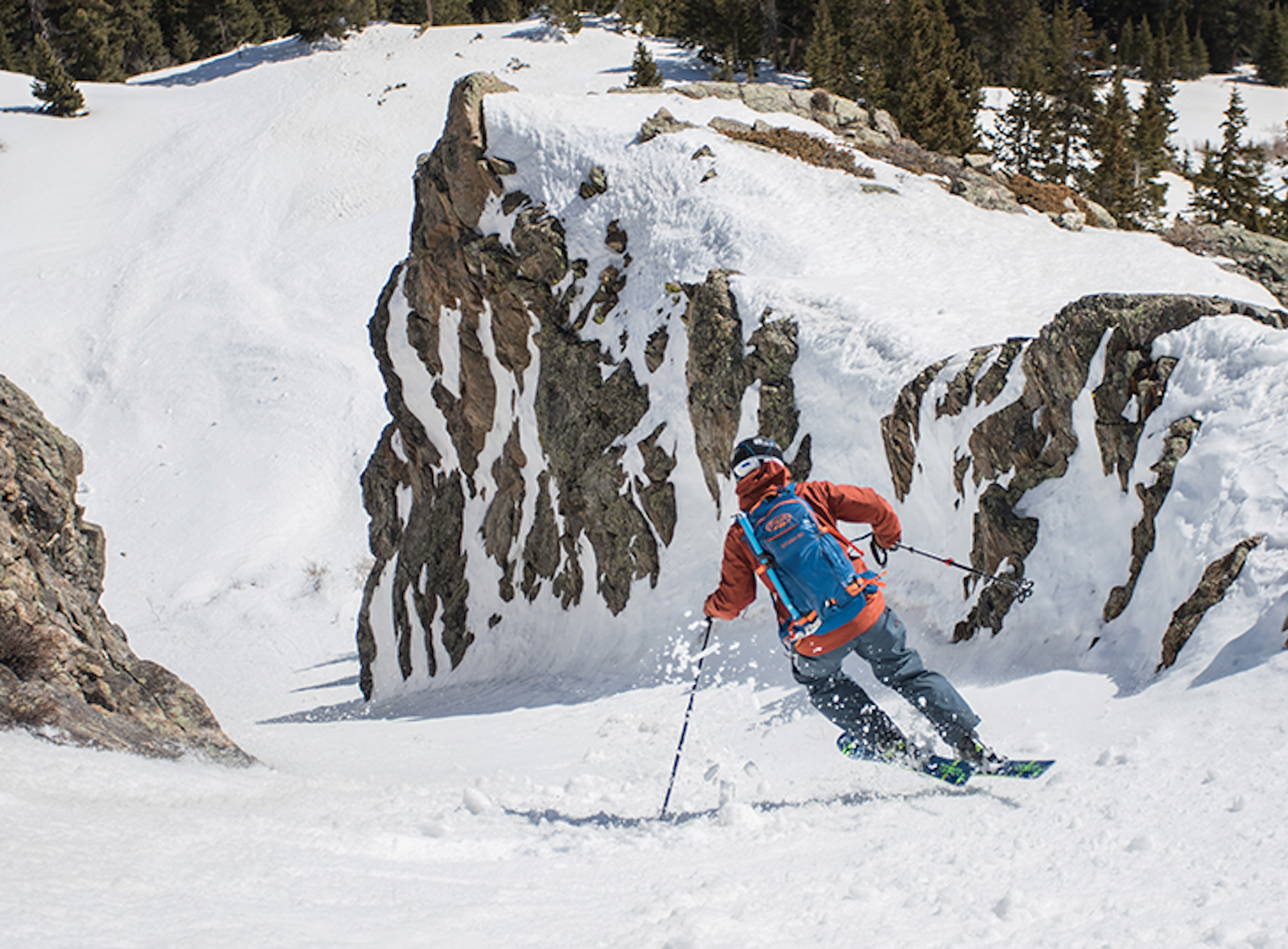
O’Neill, jumping down an unexpected chute at the bottom of London Mountain.
We slept in our cars where the dirt road met snow too deep to drive through. The full moon glowed bright, illuminating the face of 13,194-foot London Mountain, the gatekeeper of Mosquito Gulch and our side objective for the next day. It was late April and overnight temperatures sunk into the teens, freezing the snow that had softened in the day’s spring sunshine.
When the brilliant glow of the rising sun first washed over the slopes of London, we were already venturing up its lower flanks. The overnight freeze had turned our route into an ice rink, making the going slow, but the occasional loss of footing kept the laughter frequent and spirits high. Despite the unstable travel, having companions along to explore an unfamiliar mountain was pleasant and heart-warming. I imagined doing it alone, most likely in the dark like Dyer traveled, would be quite difficult.
We transitioned from skins to crampons and crafted our staircase to the top. Surely, John Dyer didn’t make pit stops to climb and ski the peaks straddling the native-made trail he followed up and over the pass in the 1860s, but one can assume he marveled at them as he traveled through. His autobiography reflected his deep appreciation for the beauty of these mountains. He described the view from atop Kenosha Pass, into the high valley of South Park east of the Mosquitos, as
“a point of view of grandeur never to be forgotten… a sight seldom surpassed even in the Rocky Mountains.”
He was right. The reward for our climb to the top of London Mountain was a 360-degree view spanning hundreds of miles. The eastern horizon held the sun low above the 10,000-foot-high valley Dyer described in his musings, flush with green pastures following a long winter. Mt. Elbert and Mt. Massive, the two highest peaks in the state, loomed westward beyond our final destination. And all around, pointed fins of granite circled us like sharks, each plastered with unique and wonderfully aesthetic potential ski lines.
“It’s a beautiful place to ski,” says Fritz Sperry, who moved to Colorado in 1992 and has written three backcountry skiing guidebooks focused on the state. “Those spring lines are usually around two to three thousand vertical of good quality steeps.”
We descended 2,000 feet of delicious spring corn, thanks to a few hours of warm up from Mr. Sun. We combined hop turns through the upper and lower narrows with big, arching turns down the middle of London’s northeast face in a steep line known as “Jack The Ripper.” Our route spit us back out in the flats near 11,000 feet where we started the day. We gazed up at our three sets of tracks in the snow and appreciated earned turns in a zone seldom traveled, yet so easy to access.
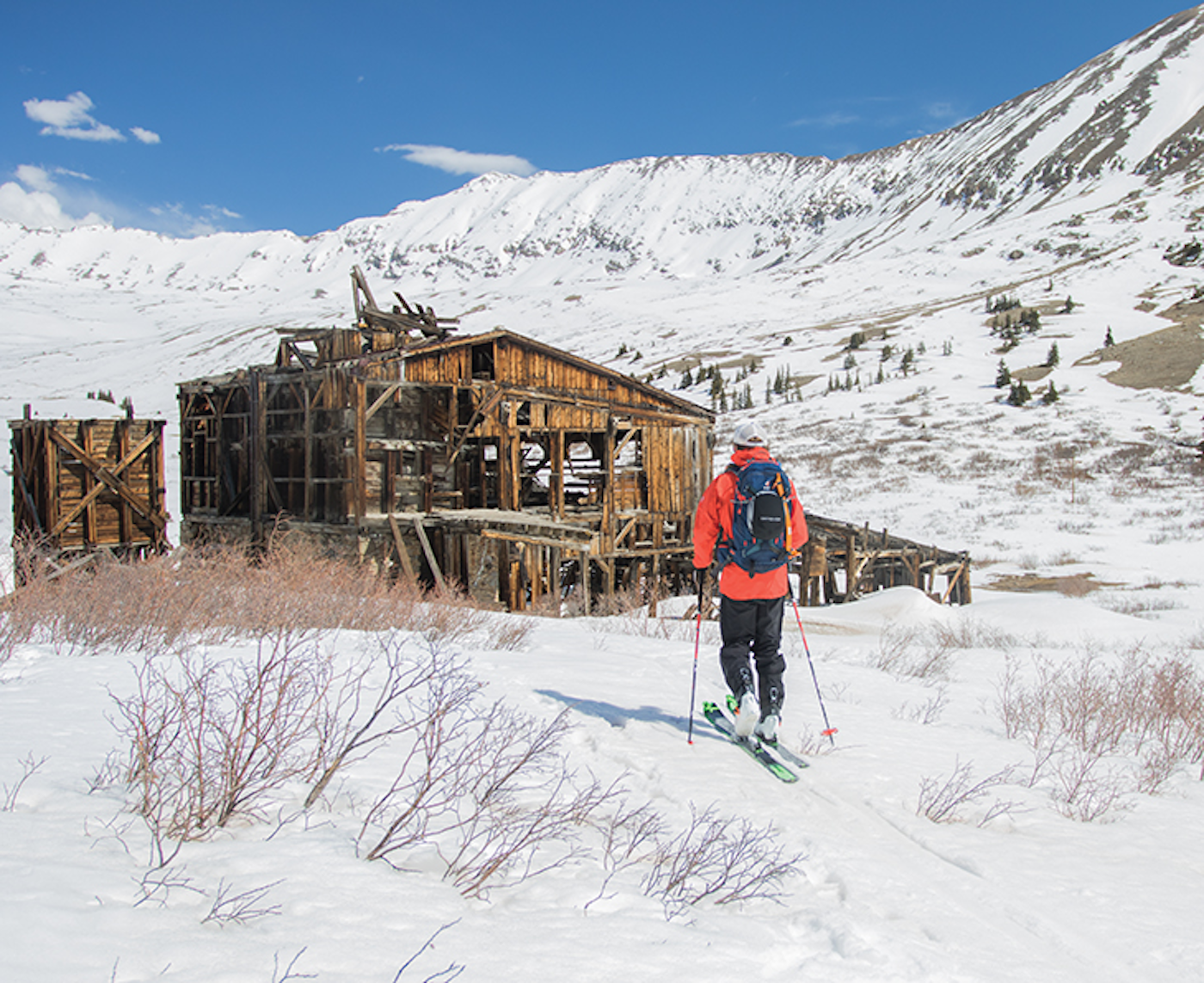
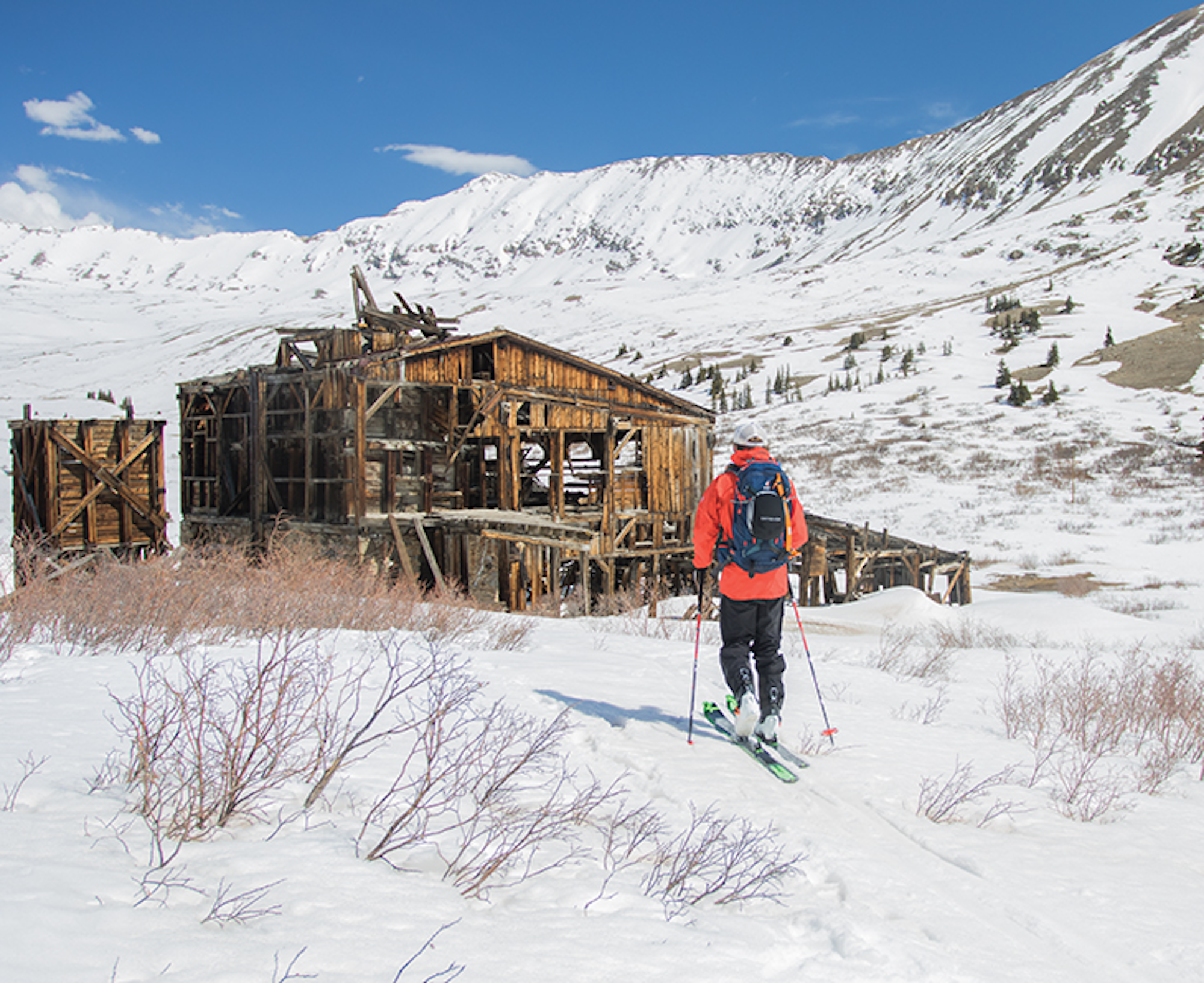
Nat Houston approaches the site of the North London Mill. North London Mill Preservation, Inc. intends to refurbish these mine ruins to be used as backcountry huts.
“Every backcountry skier owes a debt of gratitude to the miners and the fortune seekers of the frontier days,” Sperry says. “Our access, that we take for granted, is due to the hard work of the mule teams in the dynamite blasting days of yore.”
Indeed, many of the west’s high mountain paths, carved out hundreds of years ago by exploring miners and indigenous hunters, serve as the jumping off point for awe-inspiring backcountry ski zones.
The skiing around Mosquito Gulch has recently gained attention for its easily-accessed, quality skiing. So much so, that a non-profit called North London Mill Preservation, Inc. (NOLO) formed with the intention of turning the area into a group of backcountry huts, à la those of the 10th Mountain Division Hut Association.
When we encountered the remains of the North London Mine on our journey to Leadville, the buildings were barren and ghostly. However, on October 12, 2018, NOLO announced it had stabilized the mine office—stripped down the interior to the studs and joists, attached a temporary roof—thanks to a $35,000 grant from History Colorado and the Gates Family Foundation. The goal is for the office to become the first of the NOLO huts, pending the approval of $150,000 in funding from History Colorado, which will spur renovation work this spring.
“Our mission is to preserve the historic buildings there,” says Jeff Crane, NOLO president. “To me, it’s just a spectacular and provocative place. It speaks of the origins of the state, why people were there and the lives that they led in the early days.”
I’ll bet those early settlers never thought folks dressed in technical outerwear and with state-of-the-art boots, bindings and skis would be walking up and skiing down these mountains.
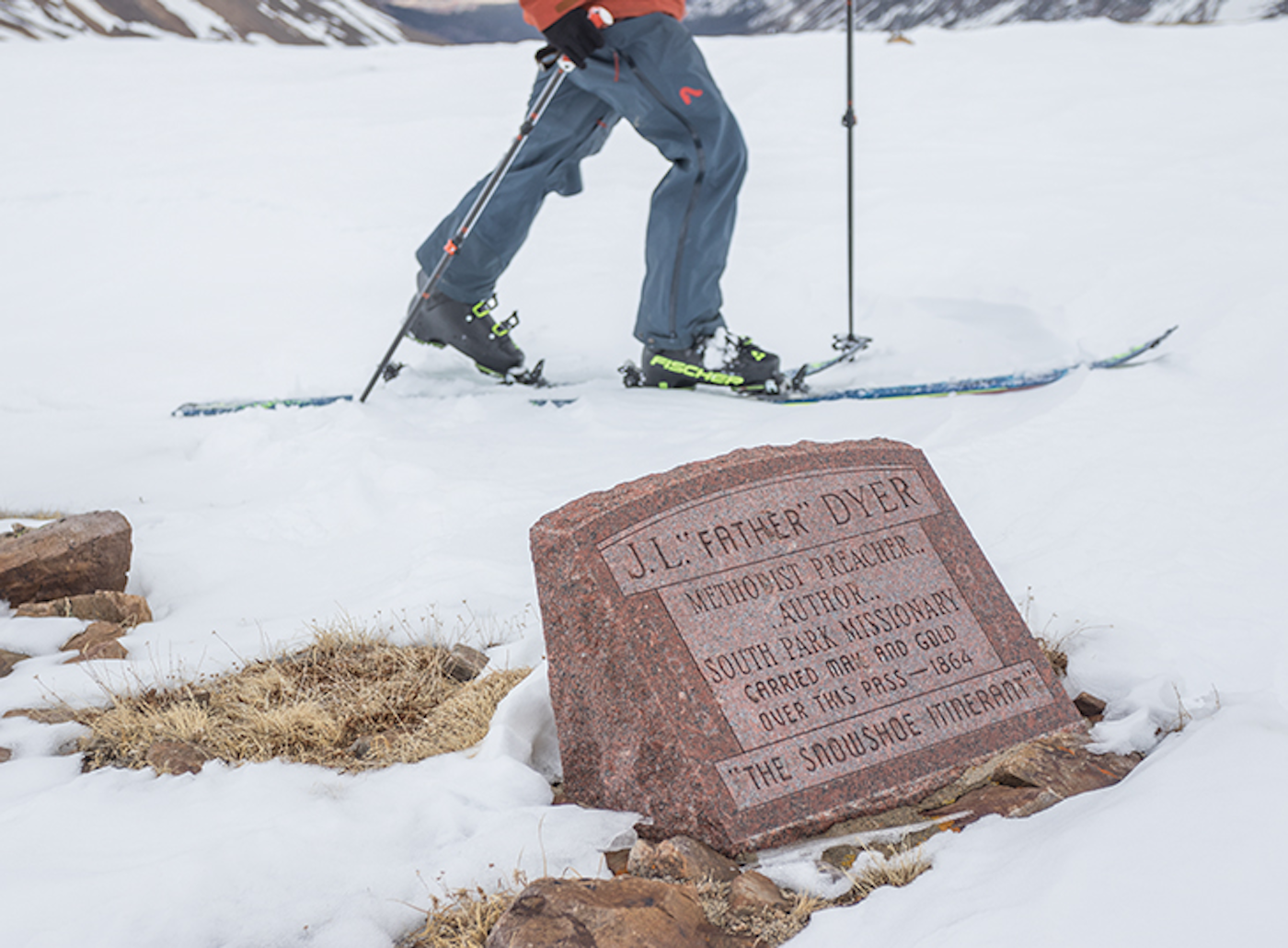
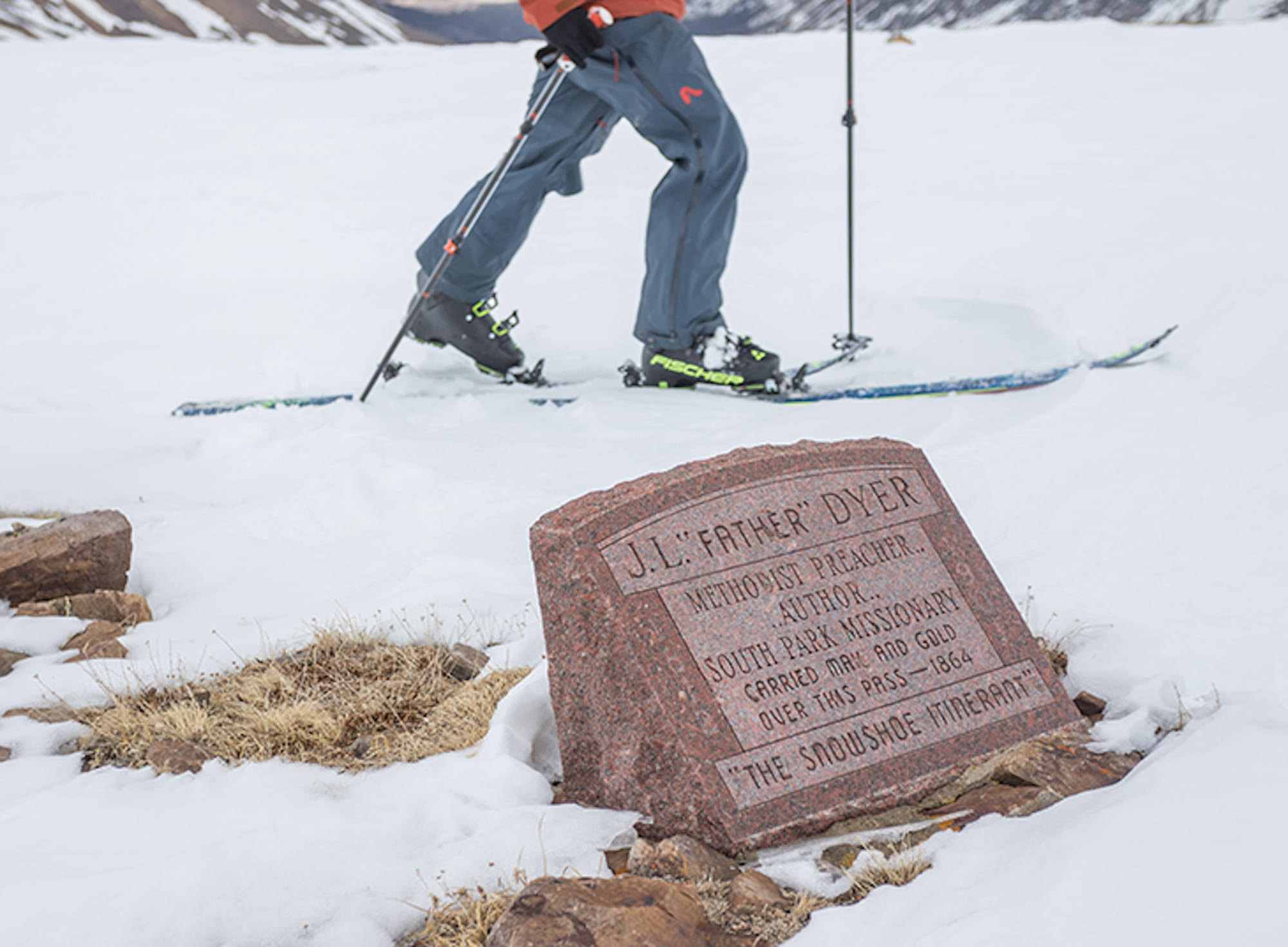
The author passes the plaque dedicated to John L. Dyer at the top of Mosquito Pass.
Nevertheless, we continued west. Somehow, despite the easy-to-follow nature of the trail, we missed a turn, putting us slightly off route. Any potential complaints of inconvenience or blame-placing were squashed when thinking about the particularly beneficial circumstances we found ourselves in. The sky was a deep blue, few clouds loitered above and the temperature rose pleasantly into the low 40s. We were on modern equipment—light, fast and strong—and had only ventured slightly off course.
It was in stark contrast to a skier spending a mid-winter’s night executing this traverse—a feat achieved regularly by Father Dyer.
“Dyer was the original badass,” says Sperry. “What we do, you know, go up and tour and ski a couloir, that’s cool. He carried a 25-pound bag on 12-foot long tele skis with no metal edges. What’s the saying? Neither snow, nor rain, nor heat… that dude crushed.”
If any of the tales documented in his autobiography are valid, then that statement is true. He encountered wolves and mountain lions, guided inexperienced travelers over the pass and took his fair share of licks attempting to downhill ski on oversized, edgeless skis. And of course, he faced the wrath of the mountains.
“I had thought I could keep my course by the bearings of the storm,” he described about an encounter with an unexpected snow storm. “But, when it struck me, it was in a perfect whirl, and I had nothing left but the shape of the mountains, and by this time the snow was so dense that it appeared to be a white wall within ten feet in any direction.”
And when it wasn’t the snow coming from overhead, it was the snow beneath his feet that threatened him.
“All of a sudden I felt ajar, and the snow gave way under me, and a noise struck my ear like a death-knell,” he said of an avalanche encounter. “About a hundred and fifty feet ahead, I came to a crack six inches wide, and the snow had settled about six inches… A week after, there was a snow-slide right from that break that filled the gorge below.”
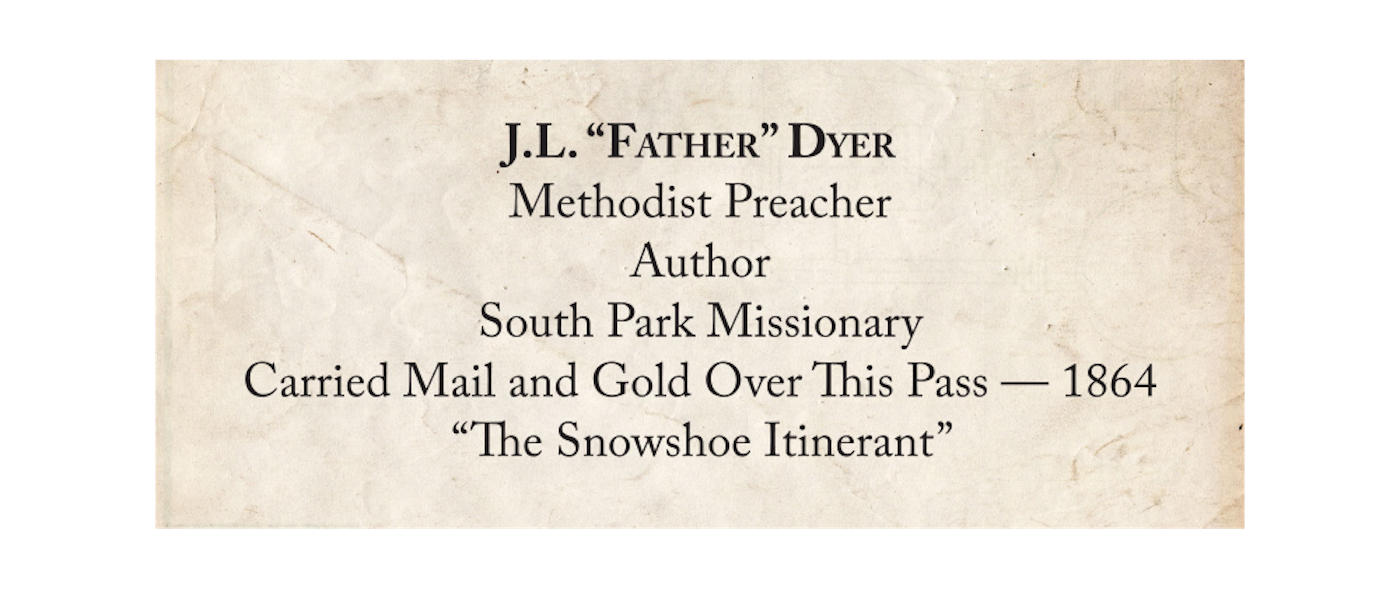
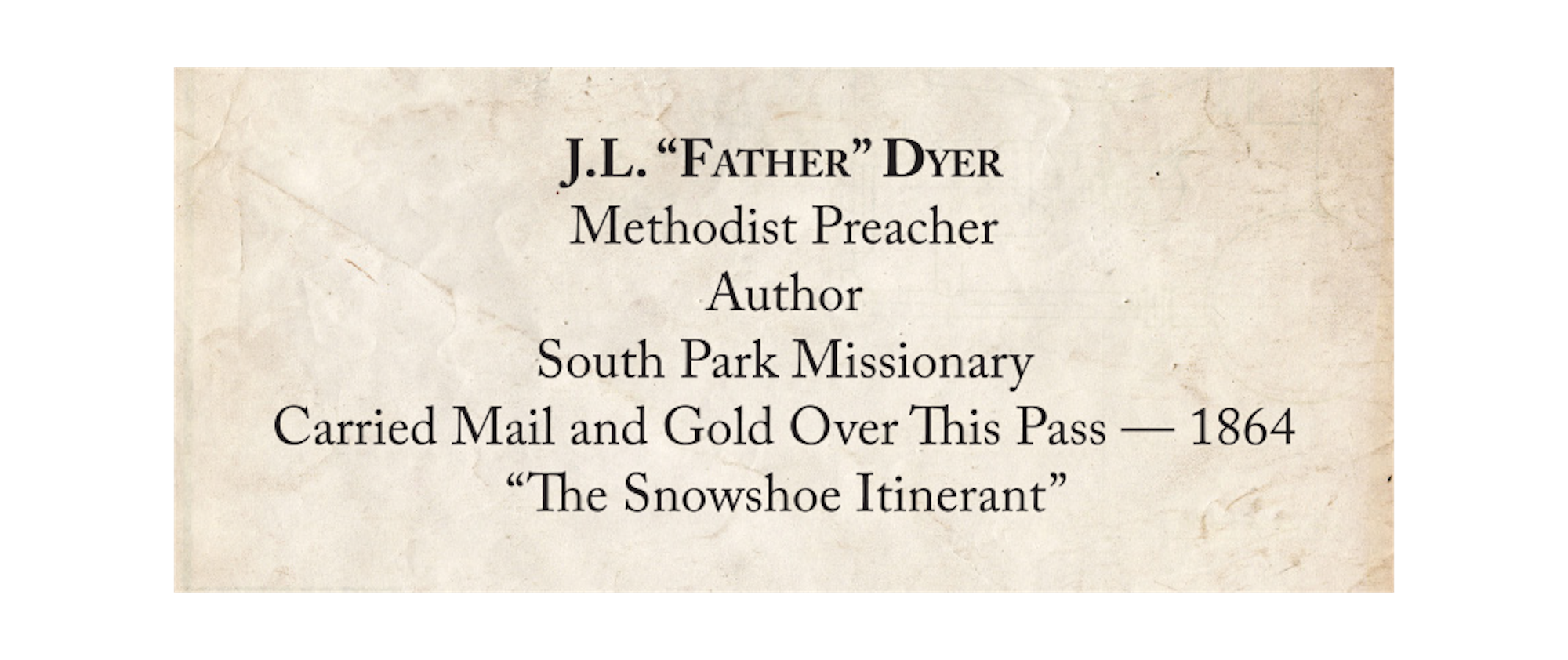
I don’t think our worries were quite as constant as ol’ Dyer’s. We finished our ascent to the pinnacle of Mosquito Pass as the sun crossed over into the western horizon. We passed the plaque memorializing the reverend.
We stood on the Continental Divide looking down the western slope of the pass and taking in the 360-degree view of the Rocky Mountains. Surely, we stood in awe of our natural surroundings as Dyer once did—an experience that transcends time.
The snowline extended all the way to the road and our shuttle vehicle, which we had left there the night prior. It was all downhill from there, a relief. I had to imagine Father Dyer had contrasting thoughts standing near there, looking east or west, knowing he’d have to navigate his oversized boards thousands of feet to the valley below. But, in the end, when it was time to settle back into his cabin in Mosquito Gulch, he felt right at home.
“How glad I was to get back, stand my snow-shoes up against the house, strike up a fire, sit down and warm a little.”

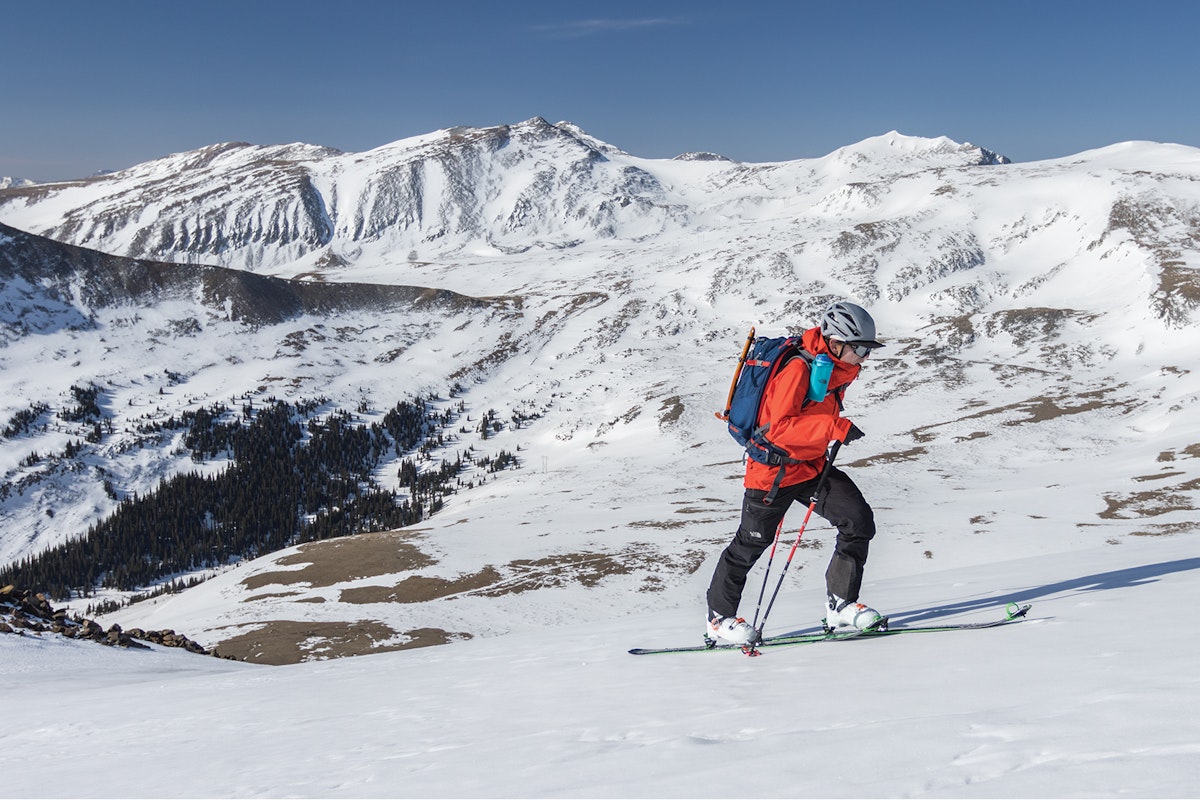
![[GIVEAWAY] Win a Legendary Ski Trip with Icelantic's Road to the Rocks](https://www.datocms-assets.com/163516/1765233064-r2r26_freeskier_leaderboard1.jpg?w=200&h=200&fit=crop)
![[GIVEAWAY] Win a Head-to-Toe Ski Setup from IFSA](https://www.datocms-assets.com/163516/1765920344-ifsa.jpg?w=200&h=200&fit=crop)

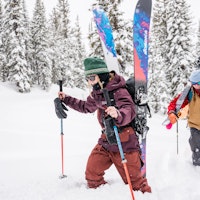
![[GIVEAWAY] Win a Legendary Ski Trip with Icelantic's Road to the Rocks](https://www.datocms-assets.com/163516/1765233064-r2r26_freeskier_leaderboard1.jpg?auto=format&w=400&h=300&fit=crop&crop=faces,entropy)


![[GIVEAWAY] Win a Head-to-Toe Ski Setup from IFSA](https://www.datocms-assets.com/163516/1765920344-ifsa.jpg?auto=format&w=400&h=300&fit=crop&crop=faces,entropy)


